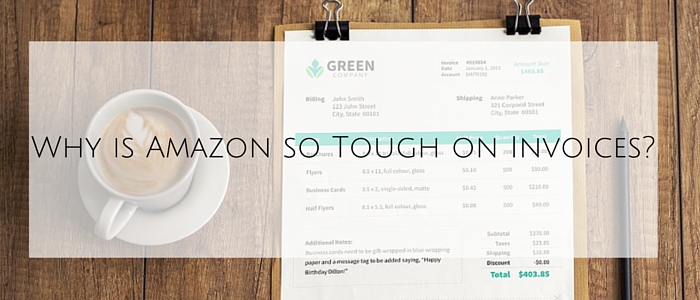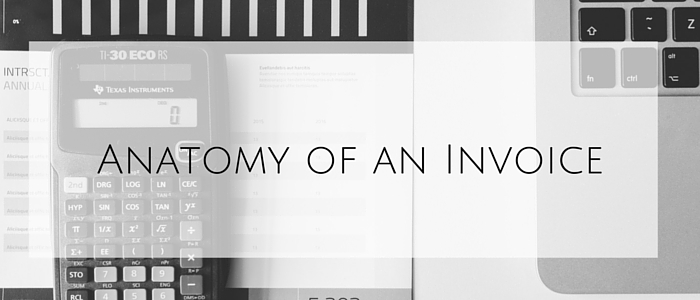In our Expert Advice Series, we will feature experts – some of them are sellers, others are well-known entrepreneurs, people who did the hard work and learned the rules of the game. All of them are willing to share their expert advice with you, so you can have a successful start of your business and a better understanding how to make a smarter buying decisions.
This week we have Cynthia Stine who is the owner of consulting firm Online Sales Step by Step and author of “Suspension Prevention: Get Reinstated and Protect Your Amazon Seller Account.” She and her fellow “Amazon Seller Advocates” help sellers get reinstated even after being denied or banned by Amazon. In this guest post she shares the perils of having the wrong invoice and what sellers can do to protect themselves if they have to defend their inventory against an Inauthentic or Counterfeit claim.
Shaking with anger, our client called us and informed us she had just fired an employee on the spot – something she had never done before – because her employee had told a terrible, terrible lie that our client then told Amazon. Her business was ruined and it is unlikely that we can save her – although we haven’t given up yet – because her employee faked an invoice. She had been clear to her employees in the past that they could no longer buy from eBay so when put on the spot to produce an invoice for a particular ASIN, the employee made a fake. It actually looked legit to us – but Amazon knew better. They knew exactly what it was.
Our client filed multiple appeals before coming to us and we’re not sure if we can get them to look at her appeal again. While the ending of this story is not yet known, I share it because we see stuff like this every day. Invoices get Amazon sellers in trouble.
In the past couple of weeks several of our clients got the ban letter for rejected invoices and several more had ASINs suspended or permanently removed because of inadequate invoices. Lately it seems to be all about the invoice with Amazon.

Why is Amazon so Tough on Invoices?
Amazon is trying to clean up the platform and get rid of counterfeit and “gray market” inventory. While only a few of our clients have actually sold counterfeit goods, the gray market has come up again and again. A claim of “inauthentic” by Amazon is about where you bought your inventory. If the history of your item cannot be cleanly traced back to the manufacturer, then it is murky. You may be buying shelf pulls if you’re buying liquidation or illegal/stolen goods if the price is just too good to be true. Your source may not have permission to sell to you for resale on Amazon. Even though your goods are legit and not counterfeit, they are not allowed on Amazon.
If you are buying from a guy on eBay (the number one platform in the world for selling counterfeit goods, unfortunately), then the provenance of your item is definitely suspect. While it is hugely unfair to the many honest sellers on eBay, you cannot prove legitimacy to Amazon of an eBay purchase. Period. Don’t buy from eBay to sell on Amazon, ever.
I can hear the wails of anguish from here, “What?!? But what if they are a major retailer or distributor selling on eBay?” Buy from their own website or brick & mortar store. Get a real invoice. It is not worth it to lose your account over an eBay purchase.
The same is true if you bought on Amazon to resell on Amazon (arggg!). If you are actually buying from Amazon itself as opposed to a third-party seller, they’ll accept the receipt BUT then you are in trouble for Used Sold as New. In Amazon’s world, any item bought from a retailer is “Used” the minute you walk out the door or open the smiley Amazon box – even if you are buying from Amazon. It is like buying a car.
We’ve recently had two clients denied because they bought from Liquidation.com one of the nation’s largest and most well-known online liquidators. They are a BBB accredited business but buying from them does not guarantee that your goods are legitimate. There are several issues with most liquidators:
- Generally there is no detailed invoice. You’ve bought “Lot 12” and it is not broken down by item and UPC code.
- The inventory may include shelf pulls (boxes not in good shape), returns and repackages which you will sell as New if you are not diligent about your inspection process.
- The inventory is usually old which means it could be defective, dried out, expired, out-of-warranty and a host of similar problems.
- You don’t know if it is legitimate. There is no connection between you and the original owner or the manufacturer.
- Technically, all liquidated items should all be sold as Used, but most sellers sell these items as New.
There are exceptions to this, but very few. I’ve seen the case where the liquidator bought directly from the manufacturer and could show a clear chain of custody – backed up by the manufacturer. Amazon reinstated the listing for my client.
888 Lots is one of the few liquidation companies that provides detailed invoices and a chain of custody for its clients if they have issues.
I’m not saying it is hopeless to get reinstated if you’ve bought from a liquidator, but it is difficult. Make sure you are comfortable with their source of inventory and that they give you a detailed invoice. Inspect your inventory closely and discard any item that is not gift-ready, clean and pristine. If in doubt, sell it as Used.

Anatomy of an Invoice
Here are the Seven Most Common Mistakes my clients make regarding invoices:
- Faking invoices. Don’t do it. Amazon is like Krampus on this issue. They KNOW when your invoices are fake and punishment is severe.
- The SHIP TO address doesn’t match the address Amazon has on file for you. It took us a while to figure this out. If you’ve moved in the past year and forgot to update your Amazon profile, if you’ve had inventory shipped to other addresses that are also part of your company, be prepared to prove it. If you use a prepping service, tell them and show them. Get supporting documentation from your prepping company if necessary that shows you are a client of theirs.
- The COMPANY NAME doesn’t match the name Amazon has on file for you. It is OK to use DBA’s in your business but make sure that Amazon recognizes them. My store name, for example, is different from my LLC. Amazon has my LLC under my tax documentation and my store name everywhere else. This is a good case for getting your DBAs registered with your State (at least) so you can prove what you own. It is $25 in Texas per name.
- Invoice doesn’t show full product name or UPC code. While it is not a requirement to have a UPC code, it really helps – especially if the product name isn’t clear on the invoice or receipt. Maybe it says “Women’s Shoes” or something vague like that. If your provider doesn’t have enough detail on the invoice, ask them for it. Tell them, “Amazon regularly asks its sellers for detailed invoices. Can you add the UPC codes to your invoices or give me more product detail?” Even having them type “See detail attached” on the invoice and then having a dated sheet with names and UPC codes will work. Make sure it is on their letterhead. This is a REAL invoice that THEY are making for you, not something you are cooking up.
- Invoice doesn’t look like all the other invoices Amazon has for that particular manufacturer/supplier. Perhaps it doesn’t have company contact information, logo, and/or isn’t set up in a typical invoice format. It was, perhaps, made in QuickBooks or in a Word file.
- The manufacturer is suspect so their invoices are invalid. I see this with private label guys who are buying from China and other countries. If Amazon doesn’t trust the manufacturer, they won’t accept their invoices as legit sources of goods. Know your partners. Check them out – regardless of where they are based.
- Selling something New that can only be sold as Used. Examples of this include Kindles and Kindle accessories, Apple products and accessories, and so on. YOU CANNOT SELL AS NEW EVER, because the manufacturer will not sell it as New to you and you must be authorized. This is not an invoice issue as much as an issue of not understanding Amazons restricted products, but if you give Amazon an Apple invoice (for example), they will assume it is fake unless you are on their list of authorized sellers.

Clean Up Your Invoices… And Your Inventory
If you are like most sellers – including me – you are thinking, “Crap, I know I have some problem inventory in there.” I suggest a two-pronged approach. For inventory that is already at Amazon that comes from a source you think might be rejected by Amazon if flagged for Inauthentic ask yourself, “Is my inventory pristine and gift-ready? Is it legit?” Be honest here, it is your account that is at stake. If you are confident and not experiencing returns for product quality issues, then sell it out and decide not to buy any more from that source in the future.
If you are nervous about your inventory, recall it, inspect it and send it back in as “Used-Like New” or “Used-Very Good.” We have rarely seen a seller suspended for selling used items as used. Most of the product quality issues are about NEW items. If you are selling used merchandise, you should be OK. Obviously this isn’t going to help if you are selling food, beauty, clothes, shoes, toys or jewelry (to name a few). In these cases you might want to sell on a different platform to get rid of your imperfect inventory.
Be sure to keep an eye on your returns closely. If you see any ASIN starting to gather returns for product quality issues, suspend it and investigate when you have two or more returns. In this way, you can nip problems in the bud. Ask your customers why their experience was less than perfect. Fix the problem and then re-list. In this way, you can keep selling inventory that has no problems but quickly catch the items that do and shut them down.
For all future purchases, think about the invoice when you are buying. Ask to see a sample invoice if this is a new source. Tell them what Amazon needs to see on the invoice and get them to work with you before you buy. Ask your supplier where he/she gets their inventory – can you trace it back to the manufacturer? Assure them that you are not trying to go around them, you just need to be able to prove the chain of custody to Amazon.
I’m doing this with my inventory. I’ve stopped buying from certain online and retail sources because their receipts are not acceptable to Amazon. As I sell out, I either find a wholesale source or I don’t sell the product anymore.
Lastly, keep track of your invoices and receipts. I can’t tell you how many times a seller had to spend hours-to-days finding a particular invoice or receipt for me. I use Shoeboxed which is an online and by-mail service. I can just stuff my paper invoices in an envelope or email digital ones to a special email box and my invoices are searchable and organized. I’m a smaller seller. Many of my clients have bookkeepers or other folks who do this for them. Just make sure you can find an invoice when you need it and that you have some kind of system for keeping track of them. Not being able to find an invoice when you desperately need it is very stressful.
Cynthia can be reached at her email address: support@onlinesalesstepbystep.com, and by phone at: 972-432-6385 ext. 402.
Disclaimer: The information and views presented in this blogpost are the opinions of the guest author, and not necessarily those of 888 Lots.







